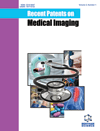- Home
- A-Z Publications
- Recent Patents on Medical Imaging (Discontinued)
- Previous Issues
- Volume 4, Issue 2, 2014
Recent Patents on Medical Imaging (Discontinued) - Volume 4, Issue 2, 2014
Volume 4, Issue 2, 2014
-
-
Image Fusion Based on Estimation Theory: Applied to PET/CT for Radiotherapy
More LessAuthors: Jinzhong Yang, Rick S. Blum, Peter Balter and Laurence E. CourtThis paper reviewed three state-of-the-art image fusion methods that were developed based on the estimation theory and evaluated these methods in the fusion of PET/CT images for radiotherapy applications. These fusion methods were developed in a framework of maximum likelihood estimate and firstly introduced the expectation-maximization algorithm to image fusion at either pixel-level or feature-level. S Read More
-
-
-
First Steps to Virtual Mammography with the Surface Evolver
More LessAuthors: M.Z. Nascimento and V. Ramos BatistaObjective: We present a full description of our virtual mammography simulator, which was already introduced in a previous short version. Herewith we give many details omitted there. Materials: We work with a professional mammographer and a transparent breast phantom. The phantom contains artificial nodules, and their displacement under compression can be easily tracked through a transparency sheet with a printed Read More
-
-
-
Effect of Contrast-enhanced Contemporaneous 18F-FDG PET/CT on Semi Quantification Uptake Value Using Third Party Viewing Workstation
More LessThis study aimed to evaluate the effect of intravenous (IV) contrast media on semi quantification value during fluorine-18 fluorodeoxyglucose (18F-FDG) PET/CT in cancer imaging. We reviewed whole body 18F-FDG PET/CT scans of 51 oncology cases performed with and without IV contrast administration. Non contrast-enhanced CT (NECT) images were acquired following IV injection of FDG then followed by contrast-enhance Read More
-
-
-
Spectral Imaging Technology - A Review on Skin and Endoscopy Applications
More LessAuthors: Yasser Fawzy and Haishan ZengSpectral imaging technology is an emerging modality that combines the advantages of both imaging and spectroscopy (high spatial and spectral resolution) in one device. The technology has potential in numerous medical imaging and diagnostic applications. In this review, we describe the techniques used to acquire spectral images and the methods used for analyzing spectral images. We then provide detailed review about Read More
-
-
-
Recent Advances in Image-Based Stem-Cell Labeling and Tracking, and Scaffold-Based Organ Development in Cardiovascular Disease
More LessAuthors: C. Constantinides, C.A. Carr and J.E. SchneiderMyocardial infarction (MI) and heart failure (HF) are leading causes of mortality and morbidity in the Western World. Therapeutic approaches using interventional cardiology and bioengineering techniques have thus far focused on either salvaging viable tissue post-infarction or preserving cardiac function in the failing myocardium. Regenerative medicine on the other hand, attempts to renew damaged tissue and enhance Read More
-
Volumes & issues
Most Read This Month
Article
content/journals/rptmi
Journal
10
5
false
en


